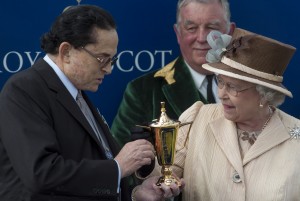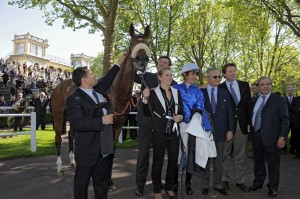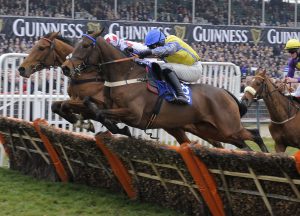It was at Deauville in the summer of 1925 – the year F. Scott Fitzgerald published The Great Gatsby – that Georges Wildenstein gave 57,000 francs for a colt bred by Atanik Eknayan. Diamonds had been Eknayan’s line; Wildenstein was trading in art.
His new colt, given the name Licteur, would become the first elite performer to carry the dark blue silks and light blue cap, taking the Prix de la Foret as a two-year-old before finishing fourth in the Poule d’Essai des Poulains. For the rest of the century, year by year, generation by generation, the family’s parallel empires – in bloodstock and art – consolidated to a point so rarefied that they gradually obtained a Jazz Age, Gatsby mystique, their immensity and lustre shadowed by secrecy.
In 1970, Georges Wildenstein’s grandson Alec stunned the art world by becoming the first to pay more than £1 million for a painting, a Velázquez, at auction. In the process, for good measure, he also became the first to pay £2 million. This was never a family to do things by halves. They had mansions in Manhattan and Paris, exotic estates in Kenya and the Caribbean.
Their racing stable housed four Arc winners, including the great Allez France. But a plain old world can seldom bear the weight of so rich a fable, and the newspapers have in recent years become ever more agog at the possibility that the whole thing may unravel almost as melodramatically as it does for Jay Gatsby.
The family’s inscrutability, for so long relieved only by an acerbic freedom in the criticism of trainers or jockeys, has been mercilessly dismantled – first by an ex-wife; then by a stepmother; and now, as though to demonstrate that Hell does have at least one fury exceeding that of a woman scorned, by the taxman.
Alec died in 2008, and his brother Guy and nephew David now find themselves presiding over a dispersal of bloodlines that have long served to corroborate the grandeur of their own dynasty. Wildenstein thoroughbreds always appeared to attest to the same aesthetic flair, the same eye for lasting class, as Wildenstein paintings. But now some of the most precious and symbolic of these elegant heirlooms are to be sold off.
Though the family will retain the rump of a stable – through Ballymore Thoroughbred Ltd, which raced Miss France to win the 1,000 Guineas in 2014 – the dispersal of Wildenstein Stables Ltd at Goffs this autumn unmistakably represents one of the most remarkable such sales in the modern era. An aggregate of 108 bluebloods will go through the ring, comprising 18 yearlings and 41 horses-in-training offered at the end of the Orby Sale, on September 28; plus 27 mares, two fillies out of training, and 20 foals to be catalogued at the November Sale.
The draft is being prepared by Castlebridge Consignment, whose Bill Dwan expresses a due sense of awe. “There may never again be a chance to buy a part of racing and breeding history like this,” he says.
“The huge attraction of any dispersal by a long established breeder is that decades of selective racing and breeding are available to provide a short cut for anyone involved in bloodstock. I grew up watching in awe such wonderful racehorses as All Along, Peintre Celebre and recently Beauty Parlour, and it’s so exciting to be involved in a small way in a part of breeding folklore. It’s also a wonderful opportunity for Goffs, and for Ireland, to host such a unique dispersal – one that should attract a worldwide audience.”
It was Castlebridge that prepared Irish Oaks winner Chicquita to fetch €6 million, the highest price paid for a horse at auction in Ireland, at Goffs November three years ago. She was the highlight of the Paulyn Dispersal, the success of which appears to have influenced the Wildenstein family in choosing a host for their own sale.
“I think it’s fair to say that success follows success,” says Henry Beeby, the delighted Chief Executive of Goffs. “They’ve been kind enough to say that they appreciated our proactive approach, our enthusiasm, and they have also seen how that follows through – that when we have a good horse, we have on many occasions in recent years exceeded the expectations of vendors. Not just at the Paulyn sale.
You could look at Jet Setting, or the fact that we have sold the world’s highest-priced Frankel yearling and highest-priced Frankel foal, which you would not necessarily expect when he stands just down the road from a leading competitor. Wildenstein Stables is a huge name in racing, and this is a historic occasion, so we hope we can repay the faith they have shown in us.”
The most luminous name in the catalogue is perhaps that of Beauty Parlour, winner of the Poule d’Essai des Pouliches and runner-up in the Prix de Diane. By Deep Impact out of a half-sister to the Australian champion Might And Power, she has a pedigree as cosmopolitan as it is classy.
There may never be a chance to buy a part of racing and breeding history like this
“Obviously with over 100 horses to sell, it is difficult to pick out standout lots,” Dwan says. “But Beauty Parlour, in foal to the mighty Kingman, has to be a headline act. Her Dubawi yearling colt is an exciting type and a good advertisement for the mare and so, too, her Dansili foal.
There are also some beautifully bred maiden fillies such as Lady of Kyushu, who is a Listed winner and multiple Group-placed filly by Smart Strike, from the family of Roderic O’Connor; or Beata, a dual winner and half-sister to Bright Sky. Among the horses-in-training, the good-looking Achibueno is an unraced Dansili two-year-old from a wonderful family and it’s no surprise that he holds a Derby entry.”
The whole draft is saturated with Turf history. Take, for instance, Adventure Seeker: an eight-year-old Bering mare, in foal to Siyouni, and grand-daughter of none other than All Along, the first US Horse of the Year to have been based overseas. Within six weeks of her success in the 1983 Arc, Patrick Biancone saddled her to win three Grade 1 races in North America, a measure not only to her own toughness – she was runner-up in the Japan Cup at three, and in the inaugural Breeders’ Cup Turf at five – but also to the sense of adventure animating her owners.
They surpassed even that mark in 1993 when Arcangues landed one of the all-time shocks as 133-1 winner, on his dirt debut, in the Breeders’ Cup Classic. He was a son of Sagace, who had retained the Arc trophy for Daniel Wildenstein (son of Georges, and father of Alec and Guy) the year after All Along. Arcangues was trained by Andre Fabre, who also provided his patron with a fourth Arc win with homebred Peintre Celebre in 1997.
Other mares to be sold include Abyssinie, a half-sister to Group 1 winner Aquarelliste out of a half-sister to Arcangues, in foal to Le Havre; half-sisters to Beauty Parlour, and to champions Loup Sauvage and Loup Solitaire, both these in foal to Australia; and a Group 2-winning half-sister to Peintre Celebre in foal to Dansili.
It is difficult to imagine that the dispersal of such a storied legacy can be unconnected to difficulties with the French tax authorities, source of excruciating publicity for a family that has always treasured its privacy.
David Wildenstein has simply said: “The time has come for us to move in a different direction.” Whatever its context, and whatever the future may hold, for now this sale would seem to represent a poignant denouement in a saga tracing to the emigration from Alsace of Georges Wildenstein’s father, Nathan, after the region’s annexation by Prussia in the 1870 war.
Though Nathan initially dealt in fabrics, his salesmanship impressed a customer who asked him to dispose of some paintings on her behalf. Nathan immured himself for ten days in the Louvre, to get his eye in, and made a sufficient commission to buy a couple of pieces by Rococo artists of the previous century: a Boucher, a Quentin de la Tour. Within days, he had sold them on at a profit. And so began a business that would one day provide authenticating accessories to some of the great magnates of 20th century capitalism, thanks to an infallible instinct for taste and trends.
But their grandson would be indebted to Nathan and his wife for another family trademark. At just four years of age, Daniel was standing on tiptoes at Auteuil and Longchamp and Saint-Cloud to slide his pennies over the counter, his grandmother standing behind to bet on every other horse. “Je gagnais donc dans toutes les courses,” he would remember wryly.
If not able to sustain quite the same strike-rate, Daniel would grow up to bring the Wildenstein bloodlines to their apogee. That first good horse, Licteur, had been sold to the French National Stud but Charlemagne and Rieur, consecutive winners of the Grand Prix de Deauville, became the first in-house stallions in the 1930s.
Nonetheless things had evolved only slowly by the time Daniel hired Maurice Zilber as trainer. The Egyptian later remembered amazing his new boss with his temerity: “‘You have very bad horses,’ I said. ‘What?’ (He cannot believe this.) ‘Yes, you do.’ But I promised him the top of the list in five years, and we make it in four.”
Then Zilber joined Nelson Bunker Hunt, leaving behind a Sea-Bird filly named Allez France. She went on to win the Pouliches, Diane and Vermeille for Albert Klimscha, before chasing home Rheingold in the Arc. Allez France then passed into the care of Angel Penna Sr., who would go on to train several other outstanding Wildenstein fillies, including Waya, Flying Water, Madelia and Pawneese.
Zilber, now training Dahlia, soon gave up trying to beat the bruising Allez France – some called her masculine; Zilber preferred “ugly” – and sent his elegant filly to become an overseas champion instead. Allez France, who crowned that vintage season in the Arc, was so formidable on the gallops that Penna would set up relays of three leads for a piece of work.
After the death in 2001 of the formidable patriarch, Daniel, Alec’s role in their Turf success became clear. Having been heavily involved in the matings for 30 years, he proceeded to race such Group 1 winners as Bright Sky, Aquarelliste, Westerner and Vallée Enchantée. Defeats for this latter pair extended the sense of continuity to the offstage atmosphere: that of Westerner prompted a breathtaking remark that “the dope-testing machine must be broken”, while Vallée Enchantée, far from being unlucky, was “ridden by an asshole who didn’t follow instructions.”
There had, of course, been a long history of big-name break-ups: Henry Cecil and Peter Walwyn, over their respective stable jockeys Lester Piggott and Pat Eddery; and even Fabre, who lost 42 horses within four years of Peintre Celebre’s Arc.
The headlines, it must be said, have since become rather more serious. But if the Goffs dispersal potentially marks the end of an era, then who knows? Perhaps someone out there, no less than Georges Wildenstein buying his first yearlings in the 1920s, will set in motion a great new cycle. The females, in particular, offer the deepest of foundations – whether proven producers, or still in training, or barely weaned.
Daniel would grow up to bring the Wildenstein bloodlines to their apogee
Besides her yearling colt by Oasis Dream, Peintre Celebre’s half-sister will be preceded through the ring by three daughters: a placed three-year-old by Smart Strike; an unraced two-year-old by Dubawi; and a foal by Invincible Spirit. In fact, for a typical flavour, look no farther than the first Wildenstein yearling in the catalogue: a grand-daughter of the Classic-placed Sadler’s Wells mare Gagnoa, herself a half-sister to Pour Moi.
The horses-in-training draft, meanwhile, includes a precious two-year-old daughter of Verveine, bordering on top-class herself and already responsible for two Group 1 winners.
“I’m lucky enough to visit a lot of nice farms and see a lot of nice horses every year,” Beeby says. “But I must say it’s very rare that you can stand there and see just one after another that are not only regally bred but look the part as well.
The yearlings I’d say are as good a collection as I’ve seen in a long time, if ever. All these horses represent generations of breeding the best to the best – and not just hoping for the best, but getting the best. It’s a once-in-a-generation sale. At most.”
No less than those seeking the seeds for an empire of their own, of course, the Wildensteins themselves need only remember the Licteur era – and borrow the faith of Jay Gatsby. “Can’t repeat the past? …Why of course you can!”





